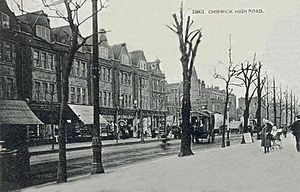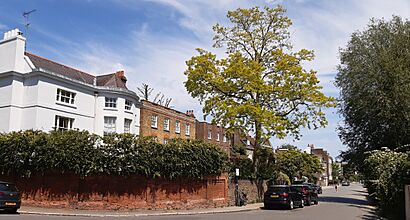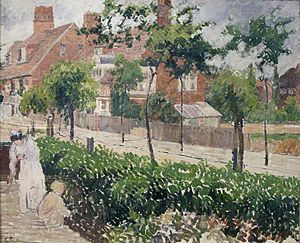Chiswick facts for kids
Quick facts for kids Chiswick |
|
|---|---|
 St Nicholas Church |
|
| Area | 5.72 km2 (2.21 sq mi) |
| Population | 34,337 (Chiswick Homefields, Chiswick Riverside, Turnham Green wards 2011) |
| • Density | 6,003/km2 (15,550/sq mi) |
| OS grid reference | TQ205785 |
| • Charing Cross | 6 mi (9.7 km) E |
| London borough | |
| Ceremonial county | Greater London |
| Region | |
| Country | England |
| Sovereign state | United Kingdom |
| Post town | LONDON |
| Postcode district | W4 |
| Dialling code | 020 |
| Police | Metropolitan |
| Fire | London |
| Ambulance | London |
| EU Parliament | London |
| UK Parliament |
|
| London Assembly |
|
Chiswick (pronounced CHIZ-ik) is a lively area in West London, England. It's part of the London Borough of Hounslow. This historic district sits along a bend in the River Thames, which is a popular spot for rowing.
Chiswick is famous for several cool places. You can visit Hogarth's House, where the famous 18th-century artist William Hogarth once lived. There's also Chiswick House, a beautiful old villa known for its amazing design and gardens. If you're interested in how drinks are made, Fuller's Brewery is London's oldest and largest brewery, right here in Chiswick! The finishing line for the famous the Boat Race is also near Chiswick Bridge.
Long ago, Chiswick was a small village with farms and fishing. Wealthy people started building grand houses along the river, especially on Chiswick Mall. Because it was easy to get to London, Chiswick became a popular country escape. It grew into a suburb in the late 1800s and early 1900s. Today, Chiswick is a well-off area with a mix of old and new homes. It includes charming spots like Bedford Park (one of the first "garden suburbs"), Grove Park, and Strand-on-the-Green. You can also find tube stations like Chiswick Park and Turnham Green. The main place for shopping and eating is Chiswick High Road.
Chiswick is also a key transport hub. The North Circular Road (A406) starts here, and the M4 motorway begins nearby, connecting to Heathrow Airport. Many famous people have called Chiswick home, including poets Alexander Pope and W. B. Yeats, artist Vincent van Gogh, and musicians Pete Townshend and Phil Collins.
Contents
History of Chiswick
The name Chiswick first appeared around the year 1000. It comes from an old English phrase meaning "Cheese Farm." People believe that a cheese fair was held every year in the Duke's Meadows area until the 1700s. The area was even settled in Roman times, as Roman coins and brickwork have been found here.
Old Chiswick started as a village around St Nicholas Church in the 1100s. People living there were farmers, fishers, and worked on the river. A ferry was very important because there were no bridges between London Bridge and Kingston for a long time. Chiswick also included smaller settlements like the fishing village of Strand-on-the-Green and Turnham Green.
A significant battle happened on Turnham Green during the English Civil War in November 1642. Royalist forces tried to take London but were stopped by a larger Parliamentarian army. The royalists had to retreat and never threatened London again.
From 1758 to 1929, the Dukes of Devonshire owned Chiswick House. You can still see their influence in many street names around Chiswick today.
In 1864, John Isaac Thornycroft started his shipbuilding company in Chiswick. His shipyard built the first naval destroyer ship, called HMS Daring, in 1893. As warships got bigger, Thornycroft moved his shipyard to Southampton in 1909.
In 1822, the Royal Horticultural Society (RHS) rented land in Chiswick for its fruit tree collection and its first gardening school. They also held their first flower shows here. The RHS later moved its main garden to Wisley, Surrey, in 1904. Some of the original pear trees from their collection still grow in the gardens of houses built on the old site.
Chiswick's population grew almost tenfold during the 1800s. New homes were built, including the famous Bedford Park in 1875, which was one of the first planned "garden suburbs."
During the Second World War, Chiswick was bombed many times. On September 8, 1944, the first V-2 rocket to hit London landed on Staveley Road in Chiswick. It sadly killed three people and damaged many homes. There's a memorial on Staveley Road where the rocket fell, and a War Memorial at Turnham Green. By the early 2000s, Chiswick had become a very prosperous area.
How Chiswick is Governed
Chiswick used to be an old parish in Middlesex. Over time, how the area was managed changed. In 1965, Chiswick became part of Greater London and joined the London Borough of Hounslow.
Today, Chiswick Town Hall is no longer the main local government building. However, it's still used for important events like weddings and civil partnership ceremonies. Chiswick is part of the Brentford and Isleworth area for national elections, and it has local councillors who represent its three areas: Turnham Green, Chiswick Homefields, and Chiswick Riverside.
Geography of Chiswick
 |
Acton Green | Bedford Park |  |
|
| Gunnersbury | Chiswick High Road | |||
| Strand-on-the-Green | Grove Park | Old Chiswick |

Chiswick is located on a bend of the River Thames, about 6 miles (10 km) west of central London. The northern part of Chiswick is more built up, while the south has more open spaces, like the beautiful grounds of Chiswick House and Duke's Meadows.
The main shopping area is Chiswick High Road, which is a long street with many shops, restaurants, and cafes. The River Thames forms the southern border of Chiswick, across from areas like Kew and Barnes. Chiswick also has a small, uninhabited island called Chiswick Eyot, which you can sometimes walk to at low tide.
To the east, Chiswick borders Hammersmith. To the north, you'll find Bedford Park and South Acton. To the west are Gunnersbury and Brentford. In the middle of Chiswick, just south of the High Road, is the Glebe Estate. This area has small terraced houses built in the 1870s on land once owned by the local church.
Chiswick is mostly in the W4 postcode area of London. Some of the most beautiful old mansion blocks, like Heathfield Court, are found around Turnham Green. Other parts of Chiswick include Grove Park and Strand-on-the-Green, which used to be a fishing village.
Chiswick's Economy
Chiswick High Road is a busy street with many shops, restaurants, cafes, offices, and hotels. Its wide pavements are perfect for outdoor seating at cafes and pubs. Since the 1960s, many office buildings have been developed here, including the 18-storey IBM headquarters built above Gunnersbury station in the 1960s. This building is now home to the British Standards Institution.
Chiswick is also home to the Griffin Brewery. This is where Fuller, Smith & Turner have been brewing their award-winning beers for over 350 years! The original brewery was in the gardens of Bedford House on Chiswick Mall.
You can find several markets in Chiswick. A weekly farmers' market is held every Sunday at Grove Park Farm House. There's also a monthly flower market and an antiques market on Chiswick High Road.
Interesting Places to Visit
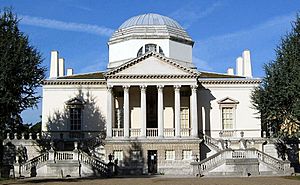
Chiswick House
Chiswick House was designed by the Third Earl of Burlington and built in the 1720s. It's considered one of the best examples of Palladian architecture in Britain, with amazing paintings and furniture inside. The gardens around the house, designed by William Kent, are also very important. They were some of the first English landscape gardens. For a while, from 1892 to 1928, it was even used as a mental health hospital.
Churches
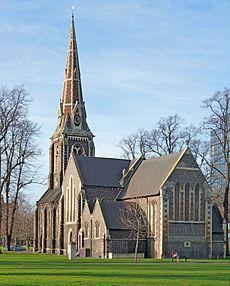
St Nicholas Church, near the River Thames, has a tower from the 1400s. The rest of the church was rebuilt in the 1880s. In the churchyard, you can find the graves of famous people like the artist William Hogarth and the landscape designer William Kent. There's also a special tomb designed by John Soane. One of Oliver Cromwell's daughters is buried here, and there's a legend that Cromwell himself might be buried with her!
Other notable churches include St Michael, Sutton Court, built in a Tudor style in 1908, and St Paul's Church, Grove Park, a Gothic stone building from 1872.
St Michael and All Angels, Bedford Park was designed by Norman Shaw in 1879. It's a beautiful red brick church and is known for its Anglo-Catholic traditions.
Christ Church, Turnham Green is an early Victorian Gothic building from 1843, made of flint and stone.
Chiswick's main Roman Catholic church is Our Lady of Grace and St Edward. It's a red brick building that opened in 1886. Its square tower was added after the First World War as a memorial.
The Cathedral of the Nativity of the Most Holy Mother of God and the Holy Royal Martyrs is a Russian Orthodox church in Harvard Road. It has a unique blue onion dome with gold stars and was built in 1998.
Chiswick Mall
Chiswick Mall is a lovely street along the River Thames in the oldest part of Chiswick. It has about thirty "grand houses" from the Georgian and Victorian eras. Many of these are now listed buildings, meaning they are protected for their historical importance. The largest house is Walpole House, which has parts dating back to the Tudor period.
Strand-on-the-Green
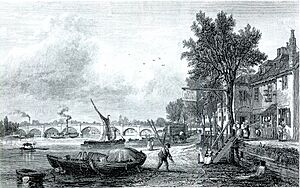
Strand-on-the-Green is the westernmost part of Chiswick. It's very "picturesque" with a paved path along the river and a row of impressive 18th-century houses. There are also three historic pubs right by the river. The path here can get flooded at high tide. It became a popular spot after Kew Bridge opened nearby in 1759, especially with the royal family living at Kew Palace.
Bedford Park
Bedford Park is famous for being the first "garden suburb." It was designed to feel like a relaxed market town or village. In 1877, a developer named Jonathan Carr hired architect Norman Shaw to design the houses. Shaw's designs, with their red brick and decorative gables, made the area look varied and charming. He also designed the church of St Michael and All Angels and The Tabard Inn, which are central to the area.
Duke's Meadows
Duke's Meadows used to belong to the Duke of Devonshire. In the 1920s, the local council bought it and turned it into a fun place for recreation. They built a promenade and a bandstand. Today, it's still used for sports like rugby, football, hockey, and rowing. A local charity, the Dukes Meadows Trust, has been working to restore the area, and they even opened a children's water play area in 2006.

Gunnersbury Triangle
The Gunnersbury Triangle is a special local nature reserve located across from Chiswick Park Underground station. This area, which is shaped like a triangle because of railway tracks, was saved from development and became a reserve in 1985. It's mostly covered in birch woodland and has different types of plants and animals. The reserve hosts many activities, including wildlife walks and open days.
Public Houses and Theatres
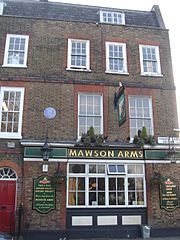
Chiswick has several historic public houses (pubs), many of which are listed buildings. These include the Mawson Arms, the George and Devonshire, the Old Packhorse, and The Tabard. The Tabard is famous for its beautiful interior designed by William Morris. Three more pubs are located in Strand-on-the-Green, right by the Thames.
Chiswick also had two well-known theatres in the 20th century: the Chiswick Empire (1912-1959), which staged music hall shows and plays, and the Q Theatre (1924-1959), which was known for new plays.
Today, the 96-seat Tabard Theatre (opened in 1985) is located above the Tabard pub. It's known for showing new and experimental plays.
Other Buildings
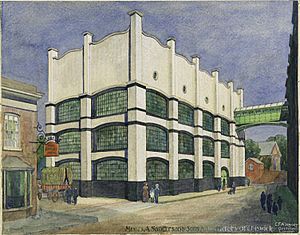
The old Sanderson Factory, now called Voysey House, was designed by architect Charles Voysey in 1902. It's a unique building made of white glazed brick and is considered an important example of Arts and Crafts factory design. It used to be a wallpaper printing factory but is now used as office space.
In 1971, Erin Pizzey started the world's first refuge for victims of domestic violence at 2 Belmont Terrace in Chiswick. Her organization, "Chiswick Women's Aid," inspired similar refuges to be created all over the world.
Chiswick is also home to the Arts Educational Schools in Bath Road, a well-known performing arts school.
You might recognize the house used for filming the comedy show Taskmaster. It's a former groundskeeper's cottage located near Chiswick Bridge.
Getting Around Chiswick
Chiswick is a major transport hub. It's where the North Circular Road (A406) begins, and the M4 motorway starts here, providing a direct route to Heathrow Airport. The Great West Road (A4) runs east into central London.
The River Thames forms Chiswick's southern border. Several bridges cross the river here, including Chiswick Bridge and Kew Bridge. You can even take river boat services from Kew Gardens Pier to places like Westminster Pier and Hampton Court.
Many bus routes serve Chiswick High Road, including the 94, 110, 237, 267, 272, 440, E3, and H91. The 94 runs 24 hours a day.
The District line of the London Underground serves Chiswick with four stations: Stamford Brook, Turnham Green, Chiswick Park, and Gunnersbury. Turnham Green is also an interchange for the Piccadilly line during certain hours. Chiswick railway station offers regular train services to London Waterloo.
Sports in Chiswick

Chiswick has several local sports teams. The Chiswick RFC rugby team plays league games at Dukes Meadows. The Chiswick cricket club plays at Riverside Drive. At the Rocks Lane Multi Sports Centre on Chiswick Common, you can hire tennis, five-a-side football, and netball courts.
The section of the River Thames in Chiswick is very popular for rowing. The famous Championship Course for rowing races runs past Chiswick Eyot and Duke's Meadows. The Boat Race, between Oxford and Cambridge universities, finishes just downstream of Chiswick Bridge. Many important rowing clubs are based in Chiswick, including the University of London Boat Club, Quintin Boat Club, and Tideway Scullers School. Many Olympic and World Champion rowers have trained here!
Famous People from Chiswick

Many famous people have lived in Chiswick over the years.
18th Century
The poet Alexander Pope lived in Chiswick from 1716 to 1719. The painter William Hogarth lived at Hogarth's House from 1749 until his death in 1764.
19th Century
In the 1800s, the Italian writer and revolutionary Ugo Foscolo died in Chiswick in 1827 and was buried in St Nicholas Churchyard. His remains were later moved to Italy, where he is considered a national hero.
Francis Ronalds, who invented the electric telegraph, lived on Chiswick Lane from 1833 to 1852. John Edward Thornycroft, a famous engineer, was born in Chiswick in 1872. His father, John Isaac Thornycroft, started the shipbuilding company here. The marine artist Montague Dawson was also born in Chiswick in 1895.

The famous painter Vincent van Gogh lived in Chiswick in the 1870s and taught Sunday school here. He described Chiswick as a "verdant" (green and leafy) part of London.
The poet W. B. Yeats lived in Woodstock Road as a boy from 1879. Later, in 1887, he returned to live in Blenheim Road, where he was inspired by Chiswick Eyot to write his famous poem The Lake Isle of Innisfree.
The Pissarro family of painters, including the Impressionist Camille Pissarro and his son Lucien, lived in Bath Road, Chiswick, around 1897. Camille Pissarro painted many notable landscapes of the area.
20th Century

In the 1900s, the novelist E. M. Forster lived at 9 Arlington Park Mansions from 1939. Playwright John Osborne wrote his famous play Look Back in Anger on his houseboat in Chiswick.
Many other notable people were born or lived in Chiswick before and after the Second World War. These include the novelist Iris Murdoch, theatre director Peter Brook, zoologist Aubrey Manning, and actress Sylvia Syms.
Rock musicians John Entwistle and Pete Townshend from The Who were both born in Chiswick during the war. Deep Purple lead singer Ian Gillan was also born here in 1945.
After the war, famous people born in Chiswick include musician Phil Collins, singer Kim Wilde, actress Kate Beckinsale, comedian Mel Smith, and cricketer Dimitri Mascarenhas.
Many other well-known figures have lived in Chiswick, such as novelist Anthony Burgess, playwright Harold Pinter, pop artist Peter Blake, actor Hugh Grant, singer Bruce Dickinson (from Iron Maiden), TV presenter Kate Humble, and musician Noel Gallagher.
21st Century
In recent times, Chiswick residents have included playwright Michael Frayn, singer Sophie Ellis-Bextor, TV journalists Jeremy Vine and Rageh Omaar, actors Colin Firth, David Tennant, and Vanessa Redgrave, and TV presenters Clare Balding and Mary Nightingale.
In the Arts
Chiswick has appeared in many books, films, and TV shows. The novel Vanity Fair (1847/8) by William Makepeace Thackeray starts at Miss Pinkerton's Academy for Young Ladies in Chiswick Mall.
The BBC TV show My Family was set in Chiswick and ran from 2000 to 2011. In 1966, The Beatles even filmed two of their first music videos for "Paperback Writer" and "Rain" in the grounds of Chiswick House.
Nearest Places
 |
Ealing | Acton | Shepherd's Bush |  |
| Brentford | Hammersmith | |||
| Kew | Mortlake | Barnes |
See also
 In Spanish: Chiswick para niños
In Spanish: Chiswick para niños




